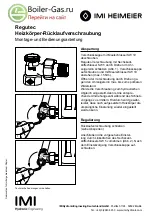
4.2
Connection of the flue gas system and flue
duct dimensions
Boiler and flue gas system must be mutually compatible
and operate as a single functional unit in order to
guarantee trouble-free and economical operation.
A moisture-resistant duct is required for the correct
operation of the Hoval BioLyt. Watertight and acid-proof
flue gas systems should be used in new installations.
Existing flue gas systems may require upgrading or
adjustment of the flue duct cross-section as indicated by
a chimney engineer. The flue draught depends, among
other things, on the following factors:
a) Type (materials and characteristics) of the flue duct
(thermal insulation, internal surface roughness, leak-
tightness, etc.).
b) Connection of the boiler to the flue gas system
according to applicable regulations and standards
c) Correctly dimensioned effective cross-section of the
flue gas duct.
re: a)
The flue duct must be moisture- and soot-fire-resistant
(a chimney engineer must be consulted).
re: b)
The flue gas pipe connecting the boiler to the flue gas
system must be as short as possible and placed at an
angle of 30-45° if possible.
Carefully seal the flue gas pipe against the flue
gas system. The insertion of the flue gas pipe into the
flue gas system must be carried out in such a way that
no condensation water can flow from the flue gas system
into the flue gas pipe and into the boiler.
The local regulations may prohibit the connection of more
than one heat generator to the same flue gas system.
• Where possible, avoid 90° bends in the flue gas system!
•
Flue gas pipes over 1 m in length must be insulated.
Installation of an explosion damper is
mandatory. The use of a combined draught
limiter-explosion damper is recommended.
The diameter of the flue gas pipe connecting
the boiler to the flue gas system must not
be smaller than that of the flue gas outlet
on the boiler. Connect the flue gas pipe to
the flue gas system elastically.
re: c)
Dimensioning of the flue duct cross-section:
The cross-sections are calculated on the basis of boilers
with a supply pressure of at least 0.05 mbar, in accordance
with EN 13384-1. Take into consideration location-specific
factors (hillside location of the building, chimney position,
roof inclination, chimney stack exit shape, etc.)!
It is advisable in every case to consult the chimney
engineer in the planning stages!
The flue draught must be in the range of 0.05- 0.25 mbar
(0.5- 2.5 mm WC or 5- 25 Pascal).
26
4 211 326 / 01
InSTALLATIOn
Summary of Contents for 30-BioLyt 13
Page 53: ...53 4 211 326 01...
















































